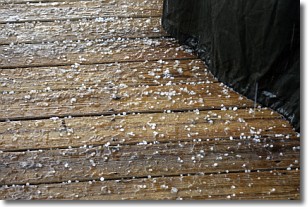Weather Alert in Texas
Beach Hazards Statement issued May 13 at 3:00PM CDT until May 14 at 10:00PM CDT by NWS Houston/Galveston TX
AREAS AFFECTED: Matagorda Islands; Brazoria Islands; Galveston Island; Bolivar Peninsula
DESCRIPTION: * WHAT...Dangerous rip currents and minor coastal flooding, especially during times of high tides are expected. * WHERE...Gulf-facing beaches, including the Matagorda Peninsula, Brazoria County beaches, Galveston Island and the Bolivar Peninsula. * WHEN...From late tonight through Wednesday evening. * IMPACTS...Hazardous beach conditions with strong rip currents, especially near jetties and piers. Elevated tides could lead to minor flooding of beaches, lots, parks and roads. This includes the lowest more-prone spots like Highway 87/24 along the Bolivar Peninsula, western Galveston Island, Bluewater Highway and Surfside.
INSTRUCTION: Remain out of the water to avoid hazardous swimming conditions. Rip currents are powerful channels of water flowing quickly away from shore...which occur most often at low spots or breaks in the sandbar and in the vicinity of structures such as groins...jetties and piers. Heed the advice of lifeguards...beach patrol flags and signs. If you become caught in a rip current...yell for help. Remain calm...do not exhaust yourself and stay afloat while waiting for help. If you have to swim out of a rip current...SWIM PARALLEL TO SHORE and back toward the beach when possible. Do not attempt to swim directly against a rip current as you will tire quickly.
Want more detail? Get the Complete 7 Day and Night Detailed Forecast!
Current U.S. National Radar--Current
The Current National Weather Radar is shown below with a UTC Time (subtract 5 hours from UTC to get Eastern Time).

National Weather Forecast--Current
The Current National Weather Forecast and National Weather Map are shown below.

National Weather Forecast for Tomorrow
Tomorrow National Weather Forecast and Tomorrow National Weather Map are show below.

North America Water Vapor (Moisture)
This map shows recent moisture content over North America. Bright and colored areas show high moisture (ie, clouds); brown indicates very little moisture present; black indicates no moisture.

Weather Topic: What is Rain?
Home - Education - Precipitation - Rain
 Next Topic: Shelf Clouds
Next Topic: Shelf Clouds
Precipitation in the form of water droplets is called rain.
Rain generally has a tendency to fall with less intensity over a greater period
of time, and when rainfall is more severe it is usually less sustained.
Rain is the most common form of precipitation and happens with greater frequency
depending on the season and regional influences. Cities have been shown to have
an observable effect on rainfall, due to an effect called the urban heat island.
Compared to upwind, monthly rainfall between twenty and forty miles downwind of
cities is 30% greater.
Next Topic: Shelf Clouds
Weather Topic: What is Sleet?
Home - Education - Precipitation - Sleet
 Next Topic: Snow
Next Topic: Snow
Sleet is a form of precipitation in which small ice pellets are the primary
components. These ice pellets are smaller and more translucent than hailstones,
and harder than graupel. Sleet is caused by specific atmospheric conditions and
therefore typically doesn't last for extended periods of time.
The condition which leads to sleet formation requires a warmer body of air to be
wedged in between two sub-freezing bodies of air. When snow falls through a warmer
layer of air it melts, and as it falls through the next sub-freezing body of air
it freezes again, forming ice pellets known as sleet. In some cases, water
droplets don't have time to freeze before reaching the surface and the result is
freezing rain.
Next Topic: Snow
Current conditions powered by WeatherAPI.com




